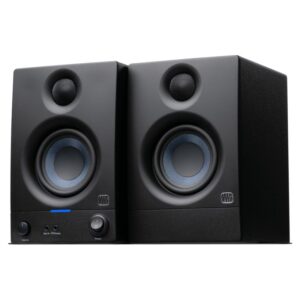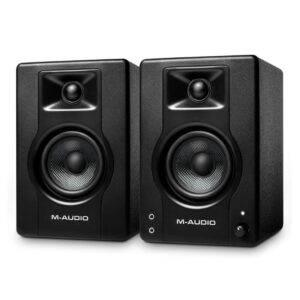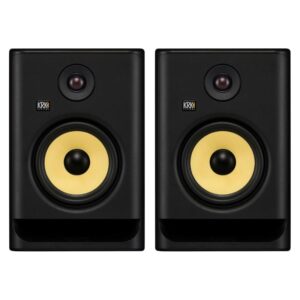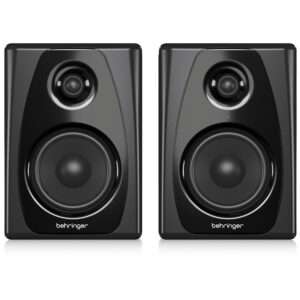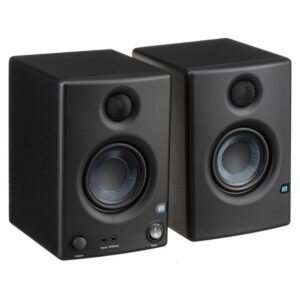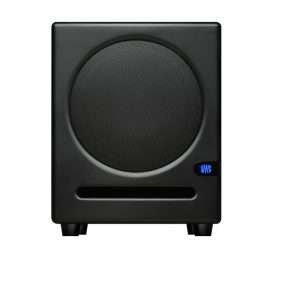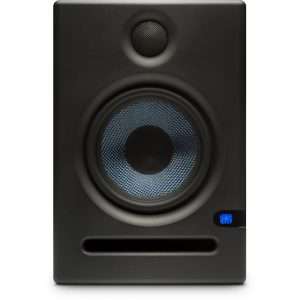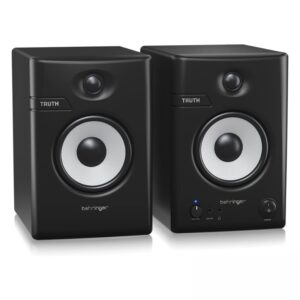Description
The Behringer STUDIO 50USB Powered Studio Monitors are a compact and versatile speaker system designed primarily for computer-based studios, multimedia workstations, and general high-quality audio playback. Their key feature is the built-in USB audio interface, allowing for direct digital connection to a computer, alongside traditional analog inputs.
They are typically sold as a pair, with one speaker being active (containing all the amplification and I/O) and the other being passive, connected via a dedicated cable.
Key Features and Highlights:
- 5-inch Long-Throw Woofer: Features a 5-inch long-throw woofer with a deformation-resistant cone (some sources mention glass fiber, others Kevlar-cone, but the principle is a robust material for good bass and mid-range response).
- 1-inch Silk Dome Tweeter: Equipped with a 1-inch ultra-high resolution silk dome tweeter for clear and detailed high frequencies.
- True Bi-Amping Mode with Digital Amplification: The speakers utilize a true bi-amplified design, meaning separate amplifiers power the woofer and tweeter for improved clarity and efficiency. They feature 150 Watts of digital power amplification (total for the pair, with separate amps for each driver). This digital amplification contributes to a high-resolution sound.
- USB Input for Direct Digital Audio: This is a standout feature. You can connect your computer directly to the active speaker via a USB Type-B cable (like a printer cable). This eliminates the need for an external audio interface for playback, making setup simple and convenient for many computer-centric users. The built-in DAC (Digital-to-Analog Converter) aims to provide good audio quality from your digital source.
- Analog Inputs (XLR & TRS): In addition to USB, the active speaker also includes traditional analog inputs:
- Balanced XLR Input (Pair): For connecting to professional audio interfaces, mixers, or other studio gear.
- 1/4″ TRS Balanced Input (Pair): Also accepts balanced or unbalanced 1/4″ signals.
- Simultaneous Use: You can often use the analog inputs simultaneously with the USB input, providing flexibility.
- Advanced Waveguide Technology: Like other Behringer monitors, the STUDIO 50USB employs advanced waveguide technology around the tweeter. This is designed to optimize sound dispersion, creating an extremely large “sweet spot” for consistent stereo imaging and listening across a wider area.
- Front-Panel Volume Control & Headphone Output: For convenience, the active speaker typically has a front-mounted volume knob for easy level adjustments. It also includes a front-panel 3.5mm (1/8″) headphone output that mutes the speakers when headphones are plugged in, allowing for private listening.
- Rear-Panel Controls for Room Adaptation: Includes basic acoustic tuning options on the rear panel:
- Tweeter Sensitivity: Allows you to adjust the high-frequency level to suit your room’s acoustics or personal preference.
- Some sources also mention volume control on the back, implying that the front control might be a master, or there’s some redundancy for setup.
- Magnetically Shielded: Designed to be placed near computer monitors without causing interference.
- Frequency Response: Offers an ultra-linear frequency response. While specific figures can vary, typically a 5-inch monitor of this type would aim for a range like 50-60 Hz to 20 kHz.
Who are the Behringer STUDIO 50USB for?
- Computer-Centric Studios: Ideal for home studios where the primary audio source is a computer, simplifying setup by eliminating the need for a separate audio interface for playback.
- Multimedia Workstations: Excellent for video editing, content creation, gaming, and general multimedia consumption where improved audio quality over standard computer speakers is desired.
- Beginning Music Producers/Podcasters: A good entry-level option for those just starting out, offering versatility with both digital and analog inputs.
- Budget-Conscious Users: Provides good features and sound quality for its price point.
- Users seeking convenience: The direct USB connectivity and front-panel controls are highly convenient.
Considerations:
- “Ultra-Linear” vs. Professional Standards: While marketed as “ultra-linear,” for serious professional mixing and mastering, a 5-inch monitor, especially at this price point, will have inherent limitations in bass extension and overall transparency compared to higher-end, dedicated studio monitors. They are a significant upgrade over consumer speakers but might not reveal every nuance needed for critical mixing decisions.
- Bass Response: While the 5-inch woofer provides decent bass, it won’t deliver the very deep sub-bass frequencies (below 50-60 Hz) found in larger monitors or with a dedicated subwoofer.
- Active/Passive Pair Design: As one speaker is active and powers the other, the cable connecting them can be a point of failure or limitation for placement compared to two fully active monitors. Some user reviews mention the included cable being short or having connection issues.
- Volume Control with USB: Some user reviews indicate that when using the USB input, the default volume can be very loud, requiring the computer’s volume to be set very low, which can sometimes affect audio resolution or fine control.
- Front Panel Material: Some older reviews have mentioned the front panel being made of plastic that might scratch easily or resonate slightly, though modern manufacturing may have addressed this.




